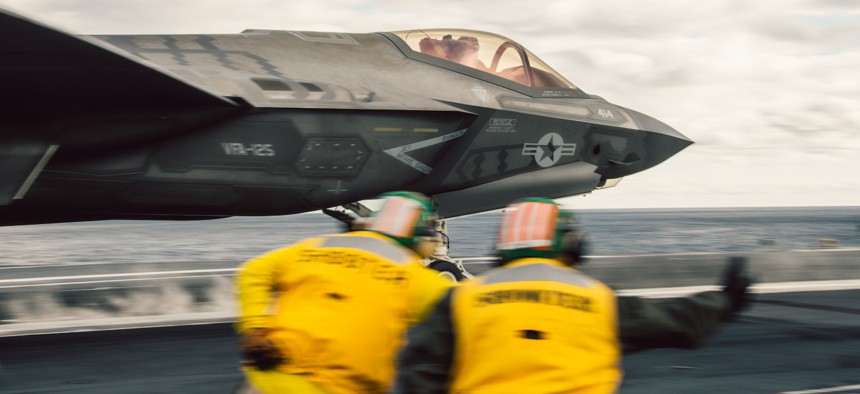Software delay will reduce F-35 deliveries for a second straight year

An F-35C Lightning II assigned to Strike Fighter Squadron (VFA) 125 launches off the flight deck of Nimitz-class aircraft carrier USS George Washington (CVN 73) Jan. 19, 2024. U.S. Navy / Mass Communication Specialist 3rd Class August Clawson
Lockheed says the TR-3 upgrade, due last year, has slipped to third quarter of 2024.
The Pentagon will be getting fewer new F-35s again this year because already-tardy software won’t be ready until the third quarter of 2024, Lockheed officials said on Tuesday.
The company will deliver just 75 to 100 of the tri-service jets this year, mostly in its second half, CEO James Taiclet told investors on an earnings call. That’s down from the 147-to-153 range announced just three weeks ago, and likely even less than the 96 or so delivered last year against the same target.
The problem is with the Technology Rollout-3 software, part of the Block 4 improvements to the planes’ sensors and weapons. Jets equipped with TR-3 were originally to begin arriving in late 2023, a date that slipped last fall to April or June.
“We're taking the time and attention to get this technology insertion right the first time because it will be absolutely worth it,” Taiclet said.
Meanwhile, Taiclet and other Lockheed officials touted other company initiatives. Work is proceeding on the Air6500, a joint effort with Australia on a battle management system to allow U.S. and Australian defense forces to share tactical data.
Taiclet also highlighted efforts to work with commercial companies on new technology and telecommunications products, citing a demonstration of 5G-connected drones last May.
“Lockheed Martin worked together with a team including Intel, Verizon, Microsoft, Juniper Networks, Keysight and Radiosys to successfully demonstrate a secure, resilient hybrid 5G and military data link network in a live field demonstration in Colorado. Our 5G dot mil unified network solutions performed as a tactical and commercial multi-node hybrid network for integrating land, air and space operations,” the CEO said.
Taiclet also described new joint ventures and investments that get at the high price of sustainment and parts through new technologies like additive manufacturing, like 3-D printing. He said these will “accelerate our additive manufacturing progress, reducing material and process dependencies and complex thermal management applications such as heat exchangers.”
As well, Taiclet said Lockheed has established a wholly owned subsidiary to accelerate microprocessor design and manufacture.
All of that underscores a wide Pentagon shift away from big bets on very expensive platforms like the F-35 toward figuring out how to use information technology to breathe new life into old platforms like the F-16 and develop new products far cheaper, products that might be able to achieve what a new-generation fighter jet could achieve but not in the form of a single new jet or program.
Those trends are a sign of the importance of big consumer tech players to future Defense Department plans and, thus, the future plans for established Defense contractors like Lockheed Martin, something Taiclet also emphasized.
“We need to start migrating towards delivering capabilities, right? So the capability would include these products that are already fielded and or new products, but especially digital technologies, which is why we are collaborating so much effort with commercial tech companies large and small.”
But for all the enthusiasm from Defense Department leaders, the government is still getting in its own way because of the way Federal Acquisition Regulation, or FAR, is written, particularly in terms of fixed pricing.
“It's going to probably take literally an act of Congress” to fix it, he said. “That will be the thing that will make our industry healthier on one hand…But it'll also invite in the commercial tech companies who are basically investing 10x what we are in [research and development, or R&D.] And we want to bring a lot of that 10x R&D, and all that talent, over into the Defense Department.”




